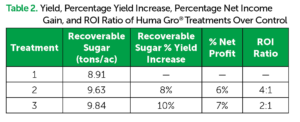Huma Gro® Ultra-Precision™ Blend Plus Root Dip Increases Strawberry Yields 30%, Univ. of Calif.
Conducted by: Surendra K. Dara, PhD, University of California
Huma Gro® Products: Ultra-Precision™ Blend; plus root dip of Breakout®, Promax®, Vitol®, and Zap®

The purpose of this research project was to evaluate how a special blend of fertilizer solution and a root dip made of Huma Gro® products with Micro Carbon Technology® affect strawberry yield when compared with a control program of grower’s standard fertilizer and a competitor root dip product.
MATERIALS AND METHODS
Strawberry cultivar San Andreas was grown on 300-feet long bed plots at a University of California research center in Shafter, Calif., on a soil that was not fumigated. A total of two beds were used for this experiment. Each bed had six subplots of 30 ft. long with an 18 ft. buffer between each subplot. This conventional production did not receive pre-plant fertilizer.
At transplanting time, sprinklers provided irrigation water and then drip irrigation was used shortly after. Two root dipping treatments were tested: (1) the grower standard included 7 fl oz of Abound (azoxystrobin) fungicide in 100 gal of water for 4 minutes immediately prior to planting, and (2) the Huma Gro® root dipping solution contained 6.4 fl oz of Breakout®, 1.28 fl oz of Promax®, 1.28 fl oz of Vitol®, and 1.28 fl oz of Zap® in 10 gallons of water for 4 min immediately prior to planting.
The grower’s standard fertilizer program consisted of 20-10-0 (a combination of 32-0-0 urea ammonium nitrate and 10-34-0 ammonium phosphate) and potassium thiosulfate applied at weekly intervals through fertigation.
The special Huma Gro® fertilizer blend containing macro- and micronutrients plus biostimulant products, known as Ultra Precision Blend (UPB), was injected through drip 12 times during the growing season, while the grower standard fertilizer was applied 20 times during the same period. Two different mixtures of UPB fertilizers were used. The first blend (which was created based on needs identified by pre-plant soil analysis) was used from planting time till December, and the second blend (based on needs identified by soil and tissue analysis during active growth) was applied from December till the end of the season. UPB Blend #2 most notably contained boron, copper, and additional calcium that was not present in UPB #1.
The marketable fruit data is from only March 11 to May 11 harvests.
CONCLUSIONS
The Huma Gro® root dip and UPB fertilizer treatment yielded 30% more marketable strawberries than the grower standard fertilizer program. The 30% yield increase due to BHN fertilizer regime gave a net return of hundreds of dollars per acre, with a ROI ratio of over 3 to 1.
Click HERE to read the full report.
Related Posts

Use of Biostimulants for Upset Recovery in Paper Mill Wastewater Systems
By Heather Jennings, PE Two specific Probiotic Solutions® liquid bioremediation products were used at a large-scale paper mill in China to address system upsets caused by hydraulic loading from new upstream processes. The products involved are Bio Energizer® (BE)—a scientific formulation of organic acids, buffers, natural biological stimulants, micronutrients, and energy systems—and Micatrol® (MT), a...

Recoverable Sugar of Sugar Beets Yield Increased Using Huma Gro® Program
Materials and Methods This trial on sugar beet (Beta vulgais) was conducted in Homedale, Idaho by SRS Farms & Crop Services. The crop was seeded on April 18 and was harvested on October 18. A basic grower’s standard fertilizer program was applied to all plots (300 lb/ac made up of MAP 11-52-0, potash 0-0-60, Tiger...

It All Has to Start With The Soil
The Soil Health Institute has released a 60-minute documentary, Living Soil, that captures the history — and significance — of the soil health movement. Our soils support 95 percent of all food production, and by 2060, our soils will be asked to give us as much food as we have consumed in the last 500...

